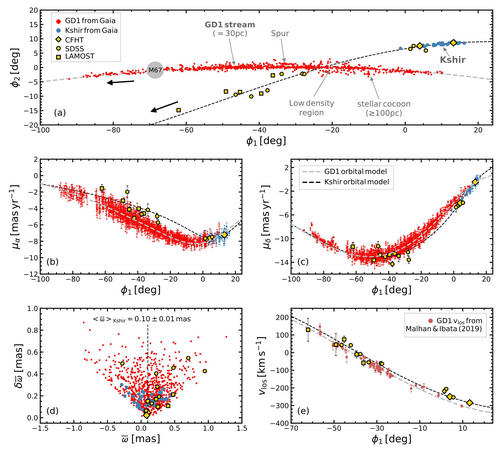An international team of astronomers from Stockholm University (Sweden), University of Strasbourg (France), University of Toronto (Canada) and OAS Bologna (Italy) have discovered a new stream of stars in the Milky Way Galaxy, named “Kshir”, which “criss-crosses” another previously well-known “GD-1” stream structure lying at similar location in the sky. The nature of this peculiar coupled stellar system is very intriguing. A likely scenario is that these two streams actually originated inside a common dark matter embryo that later merged into our Galaxy, giving rise to this observed entanglement. These findings are now published in The Astrophysical Journal.

Figure: Criss-crossing streams of the Milky Way galaxy. Every point here represents a star belonging to GD-1 or Kshir streams. The red and blue dots represent members of GD-1 and Kshir, respectively, as identified in the ESA/Gaia catalogue. The distribution of these stars are shown in the position space (a), the proper motion space (b,c) and the parallax space (d). With the radial velocity and metallcity information from LAMOST, SDSS and CFHT surveys, additional member stars were identified for the newly discovered Kshir structure (yellow symbols) (e). The additional velocity information facilitated the estimation of the orbit of Kshir in the Milky Way galaxy.
Stellar streams are “ancient” star structures that are formed by the disruption of star clusters or dwarf satellite galaxies as they orbit their host galaxy. The Milky Way galaxy is known to host over 50 stellar streams, and the importance of these “fossil” systems in probing dark matter and tracing the galaxy formation process has been well documented.
Streams emerging from low-mass progenitors, such as those formed from globular clusters, have for long been observed (and therefore perceived) as long, narrow, linear, nearly one-dimensional star structures. Moreover, they generally seem to lack associations with any other component in our Galaxy; and therefore, all the low-mass streams are generally understood as independent structures orbiting the Milky Way. This international team found some evidence that lends credence to a different understanding of stellar streams.
With ESA/Gaia’s precise astrometry facilitating efficient identification of stream members, assisted by the radial velocity and metallicity information provided by LAMOST and SDSS spectroscopic surveys as well as the observation at CFHT, this team discovered a new stream structure in our Galaxy that they named “Kshir” - inspired by Hindu mythology. Stretching for 70 degrees on the sky, Kshir is situated about 28,000 light years away from us, and orbits the Milky Way on a nearly circular trajectory. Intriguingly, this newly discovered stellar stream shows remarkable “phase-space” correlation with another structure of our Galaxy – the “GD-1” stream (see Figure). In other words, though Kshir and GD-1 are spatially distinguishable (panel “a” of the Figure), the two structures lie at similar distance, and overlap strikingly in the velocity space. This similarity in their distance and kinematics implies that these two streams orbit the Milky Way on very similar trajectories.
If GD-1 and Kshir are really independent structures, then the likelihood of such a chance alignment is very low (in fact < 1%). On the other hand, the degree of observed correlation can arguably and naturally be explained under a scenario where the two streams originated from a common parent dark subhalo (perhaps a dwarf galaxy) that later accreted onto the Milky Way. This is because, under this “accretion” scenario, the stellar contents of the subhalo system would be deposited on very similar orbits as the subhalo merges onto the Milky Way. With reliable stellar iron abundance information from LAMOST, and the other spectroscopic surveys, the mass of the “hypothesized” subhalo was tentatively estimated to be about 10^(8-9) Msun (i.e., the parent subhalo had an initial mass of about a billion times the mass of the Sun). The whereabouts of their parent subhalo is currently unknown, however, such accreted low-mass streams seem to provide very exciting avenue to probe the initial conditions of their parent dark subhalos.
Link to the paper: https://iopscience.iop.org/article/10.3847/2041-8213/ab530e

Address: 20A Datun Road, Chaoyang District, Beijing, China code: 100012
Tel: 010-64888708 E-mail: naoc@nao.cas.cn

